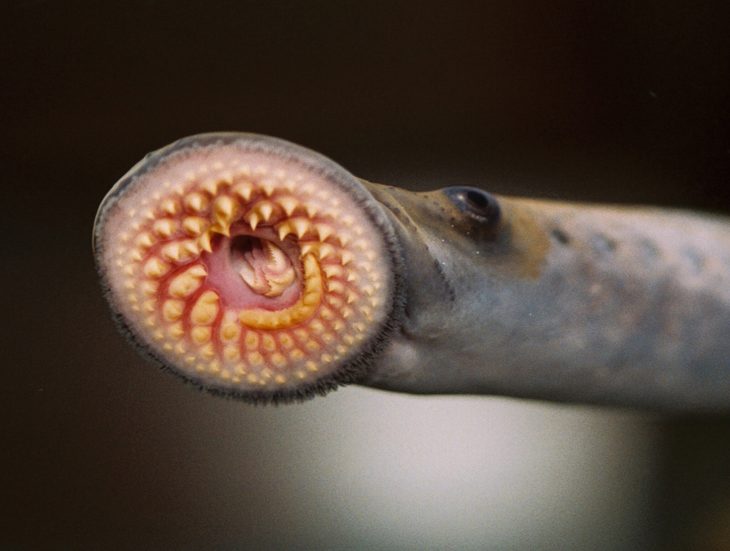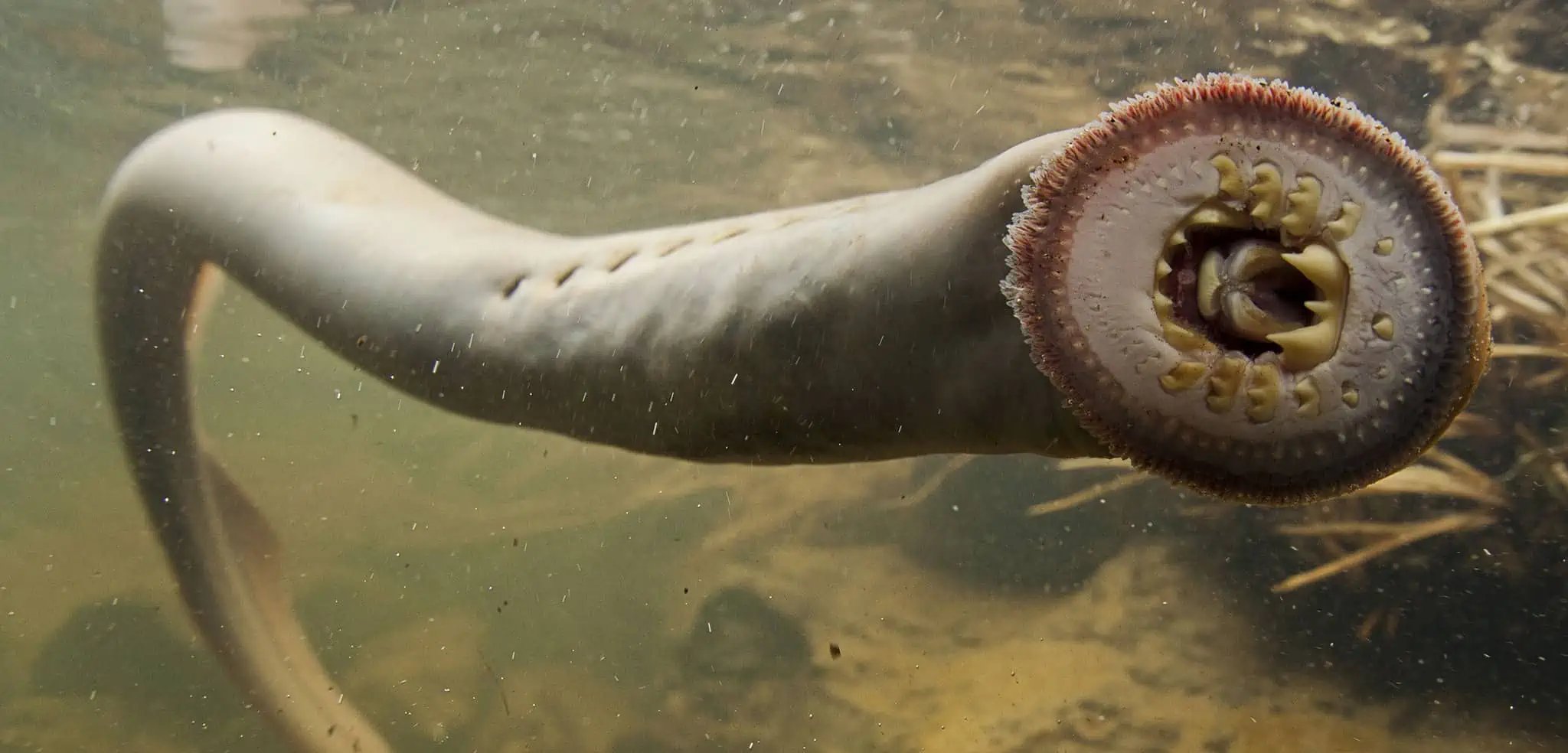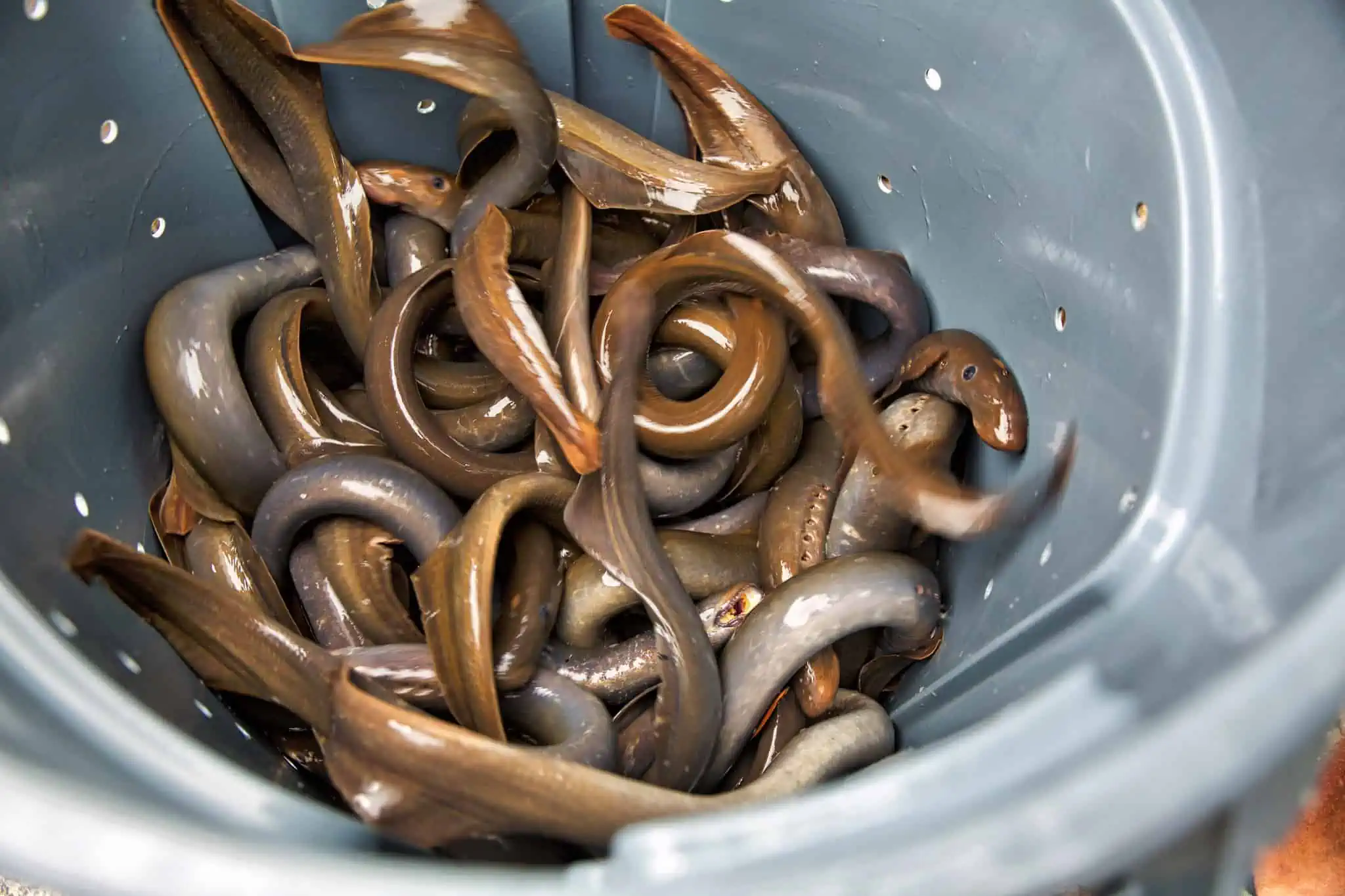
The lamprey is a scary-looking animal notorious for its jawless mouth and circular rows of sharp teeth. These eel-like creatures feed by boring holes in the flesh of an unsuspecting animal. Once it’s caught its prey, it then sucks its blood. Lampreys aren’t afraid to target fish bigger than them in the ocean, in fact, they’ve even been known to grab onto specimens as big as sharks.
These parasitic creatures look like they came out of a horror movie. And once they attack you, you will definitely feel like you are in one. Sounds bad, but if you’re not a fish, do you really have something to be concerned about? Is it true that lampreys target humans, and should we be afraid of this monster? Is the threat merely a figment of our imagination?
To set the record straight — there have been reports of lamprey attacks on humans, but, overall, they prefer fish and won’t attack us with the same ferocity as they do aquatic creatures. We can imagine a lamprey attack being a dreadful way to leave this planet.
How to find them? There are many species of lamprey worldwide, and most of them are either in the United States or Canada. The sea lamprey can be found in the open oceans of the North Atlantic and the Mediterranean, and other major lakes in North America. On the other hand, the silver lamprey can be found in the Great Lakes, Mississippi River, Ohio River, etc.
Read these lamprey facts to learn more about this mysterious fish!
- There are 38 known species of lamprey in existence. Scientists have recorded at least five of the 38 species.
- Sea lampreys have at least 12 rows of teeth arranged in circles around their mouths.
- They have seven gill openings on each side of their bodies. Their gills lie behind their eyes.
- Adult sea lampreys can weigh up to 13 pounds or 5.9 kilograms.
- Lampreys have a single nostril at the top of their heads.
- Lampreys are jawless fish.
- They breathe using their gills.
- These fish have slimy, slippery skin without scales.
- They only live in temperate regions.
- Their skeletons are made up entirely of cartilage.
- Lampreys belong to Cyclostomata, a group of jawless fishes that also include hagfish.
- Lamprey larvae are sensitive to high temperatures, which could be the reason why they don’t thrive in tropical regions.
- Lampreys generally don’t occupy and defend a single territory.
- Lampreys do not have paired fins, but have two dorsal fins.
- Their reproduction typically occurs during springtime.
- The word “lamprey” likely originated from the Latin word lampetra, which roughly translates to “stone-licker”.
- In Japanese folklore, people call lampreys “eight-eyed eels,” because the gill openings resemble eyes.
- Lampreys change of color depends on the time of the day. They are much darker during the day and paler at night.
- In George R. R. Martin’s A Song of Ice and Fire book series, the subjects of the character Lord Wyman Manderly mockingly refer to him as “Lord Lamprey”. This is likely a jab at his alleged love for lamprey pie and his obesity.
- The Pokémon character eelektross and its predecessors are based on lampreys.
Lampreys aren’t actually eels.
Adult lampreys have long, slender, and scaleless bodies, making them look superficially similar to eels. Due to their eel-like appearance, some people refer to lampreys as lamprey eels.
The name “lamprey eel”, however, is a misnomer, because lampreys are not actually eels. They belong to a separate order of animals, with lampreys belonging to the order Petromyzontiformes, and true eels belonging to the order, Anguilliformes. The most apparent distinction is that eels have jaws while lampreys lack jaws completely.
Parasitic lampreys suck the blood of other animals.

One well-known lamprey fact is that some of its species are parasitic, and live by sucking the blood and other bodily fluids of other animals.
The sea lamprey, for example, is also called the vampire fish, because of its blood-sucking feeding method. These parasitic fish use their round mouths like suction cups to latch onto their prey. They also use their multiple rows of sharp teeth to anchor themselves on the bodies of the animals they feed on.
Similar to leeches, lampreys secrete enzymes that prevent the blood of their prey from clotting. This gives them a steady flow of blood. Some species of lampreys have even evolved to not just eat the blood of other animals — they also eat the flesh! These species use their teeth to bite off the flesh of their prey. A few species may even invade other animals’ internal organs to get food. Yikes!
A single lamprey can consume around 40 pounds of fish in its lifetime.
Lampreys typically feed on many types of fish such as salmon, burbot, catfish, trout, and sturgeon — and they are pretty voracious eaters. A single adult lamprey can consume as much as 40 pounds or 18 kilograms of fish in its lifetime. They can be quite lethal as well, especially for smaller fish. Among all the fish that lampreys feed on, only about one in seven can survive. Now that’s definitely one of the most hair-raising lamprey facts.
There are non-carnivorous lampreys.
Although the most popular species of lamprey are the carnivorous and parasitic ones, there are more non-carnivorous species of lampreys. Out of the 38 known species of lamprey, only 18 of them are carnivorous. The non-carnivorous species, such as the American brook lamprey with the scientific name, Lethenteron appendix, evolved from carnivorous ancestors. Also, all of these species dwell exclusively in freshwater habitats and do not migrate into the sea as adults.
The adults of the non-carnivorous species do not eat at all.
Upon taking up a non-carnivorous lifestyle, the species that don’t feed on animal matter actually do not eat at all as adults. The adults of these species only live off of the leftover energy they stored from eating while they were young.
As a result, the adults of these species typically have smaller mouths and poorly-developed teeth, making them useless for attaching themselves to prey. Because these lampreys do not have to eat anymore, they have to focus on reproducing until they starve to death. It might be gruesome, but it works for them. Various other animals such as crane flies, black soldier flies, and some species of moths do the same.
Lampreys are the only living vertebrates that have four eyes.

Some types of animals have a parietal eye — essentially a third eye that can see light. This parietal eye rests on the top of the animal’s head, and functions to help regulate the circadian rhythm and other hormonal functions.
Typically, its skin covers the organ, and it’s not readily visible. Animals that have this organ include frogs, salamanders, tuataras, most lizards, sharks, some fish, and lampreys. Most lampreys, however, have an extra parietal eye, which essentially means they have four eyes. This makes the lamprey the only living vertebrate that has four eyes.
They do not have ribs.
Rib cages exist to provide support and protection to some of our most vital internal organs. Although these bones are common among vertebrates, not all species have them.
Frogs and lampreys, for example, do not have any ribs at all. That’s definitely one of the most unusual lamprey facts you’ll have to remember!
Baby lampreys eat by filter feeding.
All species of lampreys start their lives off by being toothless and harmless creatures. Scientists refer to baby lampreys as larvae or ammocoetes, and these little animals eat by filter feeding. Upon hatching, they drift downstream until they reach soft silt beds, where they bury themselves and feed on microorganisms, plant and animal waste, and other organic materials.
Larvae or ammocoetes have underdeveloped eyes that can only sense light and dark. Interestingly, they also have light-detecting cells throughout their bodies, especially in their tails. These cells allow them to detect light changes throughout their bodies and help them stay buried in the sediment.
They undergo metamorphosis.
Depending on the species, lampreys can spend anywhere between one and eight years as larvae or ammocoetes. They then turn into adults by undergoing a process of metamorphosis, which involves a rather drastic transformation from larvae into adult lampreys.
The process of metamorphosis can take several months, and the lampreys don’t eat in this period. By undergoing metamorphosis and turning into adults, they lose some organs such as their gallbladder and biliary ducts. In turn, they get fully developed eyes, and in some species, fully functional mouth and teeth.
They migrate from freshwater to saltwater and back, like salmon.

Of the 18 species of carnivorous lampreys, nine of them are anadromous. This means that they hatch in freshwater habitats such as rivers, then migrate to the sea, once they reach adulthood. They begin to prey on other animals as they make their way from rivers, brooks to the sea.
These species of lampreys spend about two to four years in the sea before they breed. Similar to the salmon, lampreys make their way upstream to freshwater habitat once more, when it’s time to reproduce and lay eggs. They know when it’s time to migrate because of the changes in the water temperature.
Lampreys can lay up to 100,000 eggs.
The mating habits of lampreys are generally poorly understood, but they’re known to reproduce externally. Adults move rocks around to create nests or redds where the female lampreys lay their eggs. The male lamprey entwines himself with the female, and fertilizes the eggs as the female lays them.
Male lampreys can also fertilize the eggs after females lay them, allowing multiple male lampreys to fertilize a single female’s eggs. This is an effective strategy especially because female lampreys lay a lot of eggs. The number of eggs spans from the thousands and even as many as 100,000!
They typically die after spawning.
Lampreys are semelparous animals, which means that they only get to breed once before they die. These animals spend most of their time as larvae, become adults for a few years, then die shortly after reproducing.
Some may live for a few months to guard the eggs, but the parents don’t provide parental care after hatching. This is certainly one of the most tragic lamprey facts to remember.
They have a strong sense of smell.
Although some lampreys have four eyes, they rely more on their sense of smell to get around. In fact, many even call them “swimming noses” because of their acute sense of smell. Their strong sense of smell allows them to detect predators and prey, even at night. This trait also allows them to use odor to communicate with each other.
Adults can communicate with each other via pheromones.
Lampreys do not typically interact with each other as larvae, and they mostly feed alone until they grow into adults. Adult lampreys, on the other hand, can band together and feed on a common host. They can communicate with each other by secreting pheromones.
As stated above, lampreys use their well-developed sense of smell to communicate with each other. By releasing and detecting pheromones, lampreys can coordinate their spawning periods to determine the best spots to lay their eggs. Also, when lampreys are in danger, they release alarm cues that signal other lampreys to be wary and avoid the area.
They can grow up to 40 inches long.

Lampreys can grow to be pretty long. The slender, eel-like bodies of adult lampreys can range from five to 40 inches or 13 to 100 centimeters. Now that’s some impressive yet terrifying facts!
Lampreys are quite efficient swimmers.
Most fish move in the water by using their fins to push their weight in the direction they want to go. Lampreys, however, bend their slender bodies to generate low pressures in the surrounding water.
This causes water to rush in and propel their bodies forward, and it essentially means that they pull their weight rather than push it like other fish. Although this method of swimming isn’t any faster than how other fishes swim, it’s a highly efficient method that saves a lot of energy.
They haven’t changed much for more than 360 million years.
Because lamprey skeletons consist of cartilage, we only have a few fossil records of them. However, with the rare fossil records we have, scientists determined that lampreys haven’t changed much over the course of their evolutionary history. The oldest recorded fossils we have of lampreys are those of a species that lived around 360 million years ago.
This extinct species, with a scientific name of Priscomyzon riniensis, looks very similar to lampreys alive today. It’s interesting to note that lampreys survived four major extinction events without having a lot of drastic changes in their anatomy!
Some lampreys have the highest number of chromosomes among vertebrates.
Chromosomes are large molecules that contain numerous strands of DNA, and they contain all of the genetic material of many living organisms. Humans have a total of 46 chromosomes. Northern lampreys also called Petromyzontidae, have 164 to 174 chromosomes. This makes them the vertebrates with the highest number of chromosomes! How’s that for some interesting lamprey facts?
They are ecologically important.
Lampreys play an important ecological role in their native habitats. These fish process, store, and transport nutrients by turning compounds from waste products and microorganisms into nutrients that larger organisms can use. They are prey to a number of different animals and are also vital in transporting nutrients from the sea into their freshwater habitats.
Sea lampreys don’t have a lot of natural predators.
In their native habitats, lampreys typically have a lot of natural predators like fish, birds, and some aquatic mammals. The helpless larvae often become prey items for bottom feeders. However, in introduced areas, sea lampreys can quickly overrun the local ecosystem because of the lack of natural predators.
Sea lampreys are an invasive species in the Great Lakes region.
The Great Lakes region is home to a variety of fish including some species of lamprey. Silver lampreys with the scientific name of Ichthyomyzon unicuspis, chestnut lampreys called Ichthyomyzon castaneus, and American brook lampreys also called Lethenteron appendix are native to the region. However, another species of lamprey sneaked its way into the Great Lakes region and wreaked havoc.
Sea lampreys are native to the Atlantic Ocean, but they have found their way into the Great Lakes in the 1830s via the Welland Canal.
Because they lack any natural predators in the Great Lakes, lampreys run rampant as an invasive species in the region. Their introduction to the region disrupted the local ecosystem, and lampreys decimated the populations of local fish species in the early 1900s.
They have chemicals designed to target them.
When people became aware of the destruction that sea lampreys caused in the Great Lakes region, various organizations began to launch numerous efforts to keep the lamprey population in check. One such effort is to curb the use of lampricide, which is any chemical that targets the larvae of lampreys.
These chemicals are generally not toxic to most other fishes, but they can negatively affect amphibians and other primitive species such as sturgeons. In addition to lampricides, scientists also make use of pheromones to help in trapping and eradicating lampreys.
Lampreys are popular as food.

Perhaps the most significant predators of lampreys are humans. Humans have long used lampreys as food — eating them has been popular since ancient times. The ancient Romans favored these abundant animals, and lampreys were also a staple in the Middle Ages.
They were especially important during Lent, a period in which Christians do not eat traditional meat. In modern times, lampreys are still an important feature of many cuisines such as in Estonia, Finland, Japan, Lithuania, Russia, South Korea, and Sweden. Queen Elizabeth II’s coronation pie in 1953 was even made out of lampreys!
It’s important to note, however, that some lampreys contain toxic compounds. These species include the Caspian lamprey also called Caspiomyzon wagneri, the sea lamprey also known as Petromyzon marinus, and the river lampreys called Lampetra fluviatilis and Lampetra planeri. Safe consumption of these species requires extra caution and thorough cleaning before cooking.
King Henry I of England supposedly died of eating too much lamprey.
One of the most interesting lamprey facts is that, once upon a time, they reportedly killed a king. They killed him, not by eating him, but by being eaten themselves. King Henry I of England was notoriously fond of eating lampreys.
As he grew older and developed poor health, however, his physician advised him not to eat too much lamprey. The fish is rich in calories and might pose a danger to the king’s deteriorating health. It was hard for him to resist temptation, however. Against his physician’s will, he still ate copious amounts of lamprey dishes and ultimately died.
Their larvae make good fishing baits.
Aside from eating lampreys, humans also make use of these fish for various other purposes. Lamprey larvae, for example, make good fishing baits. Using them as dead bait to catch several species of fish is especially popular in Britain.
Scientists often use them for biomedical research.
Lampreys also make for good animal models in biomedical research. They have been in use in scientific research since the 1960s. Lampreys hold significant importance in understanding the development of our early vertebrate ancestors due to their primitive anatomy.
Their simple brains and nervous system are also important for neurological research. Moreover, scientists postulate that they may also hold implications for research regarding cancer and regeneration.
People in the 12th century thought that all lampreys were female.
The Aberdeen Bestiary, a compendium of animals in the 12th century, stated that all lampreys were female. To reproduce, these animals mated with snakes. With modern science, however, we now know that this is completely false. Lampreys are fish, after all, and not even closely related to snakes!
The Roman orator Vedius Pollio kept ponds of lampreys and occasionally tossed humans into them.
In ancient Rome, the renowned Roman orator Vedius Pollio famously kept ponds of lampreys. He was notoriously cruel to his slaves, and he kept these lamprey ponds solely to punish his slaves if they did anything to displease him.
On one famous occasion, he attempted to execute a slave by tossing them into the pond because the slave broke a crystal cup. Emperor Augustus, who was staying as Vedius Pollio’s guest at the time, stopped the execution. To further teach Vedius Pollio a lesson, Emperor Augustus also ordered his men to destroy all of Vedius’ drinking vessels.
In the wild, lampreys rarely attack humans.
Although lampreys look scary and dangerous especially with their rows of sharp teeth, they rarely attack humans in the wild. Lampreys typically prefer cold-blooded animals such as fish, although they can still attack humans when they’re starving. They can also attack humans by mistake, and they can be quite hard to remove once they latch on to you.
In some parts of Portugal, people make Christmas desserts that look like lampreys.
Portuguese nuns have been making egg yolk-based pastries for centuries, and one unique example of these desserts is called “lampreia de ovos,” or egg lampreys. Some pastry shops also sell these yellow-hued desserts during the Christmas season. Lampreia de ovos doesn’t actually contain lamprey, but the Portuguese aren’t really opposed to the idea of eating actual lampreys.
The Portuguese have a long history with lampreys as food, and they use this scary fish as a substitute for red meat. In fact, a 16th-century cookbook, the oldest known Portuguese cookbook, only had one recipe for fish. And yes, it was for lamprey!
Was this page helpful?
Our commitment to delivering trustworthy and engaging content is at the heart of what we do. Each fact on our site is contributed by real users like you, bringing a wealth of diverse insights and information. To ensure the highest standards of accuracy and reliability, our dedicated editors meticulously review each submission. This process guarantees that the facts we share are not only fascinating but also credible. Trust in our commitment to quality and authenticity as you explore and learn with us.
